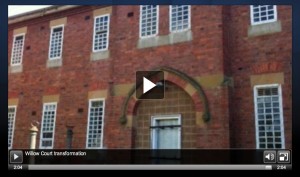 ABC News, Restoration of Willow Court
ABC News, Restoration of Willow Court
Tonights ABC News story of restoration at Willow Court also
contains an interview with Mayor Martyn Evans,
David Llewellyn and Haydn Pearce.
Past to Present. Memory to Action
 ABC News, Restoration of Willow Court
ABC News, Restoration of Willow Court
Tonights ABC News story of restoration at Willow Court also
contains an interview with Mayor Martyn Evans,
David Llewellyn and Haydn Pearce.
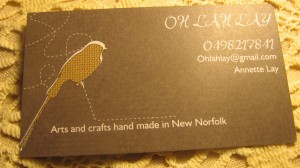 The ongoing collection of local business continues with the adding of two more, Annette Lay is about to open a new business, OH LAH LAY selling her own hand made arts and crafts in the old Nurses Quarters while upstairs there has been reports of a recording studio being set up.
The ongoing collection of local business continues with the adding of two more, Annette Lay is about to open a new business, OH LAH LAY selling her own hand made arts and crafts in the old Nurses Quarters while upstairs there has been reports of a recording studio being set up.
It’s a great place to enjoy a light meal and a brouse through the Artisans shops and Antique dealer. The “local” theme that Haydn and Penny Pearce had chosen has encouraged the small cottage industry in the district.
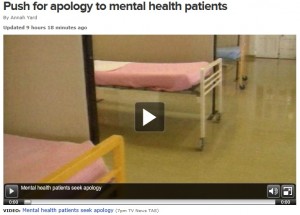 Use link to go to ABC site Push for an apology Important recognition of the past which will help us understand the present and pathways to our joint future. Contains footage from E Ward
Use link to go to ABC site Push for an apology Important recognition of the past which will help us understand the present and pathways to our joint future. Contains footage from E Ward
Dr. Dianne Snowden and Hon. David Llewellyn AM talking over restoration with Rod Quarrel at todays working bee.
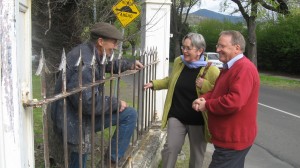 Audio here https://willowcourttasmania.org/audio-documentaries/
Audio here https://willowcourttasmania.org/audio-documentaries/
Gallery here: https://willowcourttasmania.org/pictures/working-bee-gallery/
Media Release here: https://willowcourttasmania.org/education-and-media-packs/media-releases/
New Norfolk News:http://www.newsnn.net/2012/10/friends-tackle-fence.html
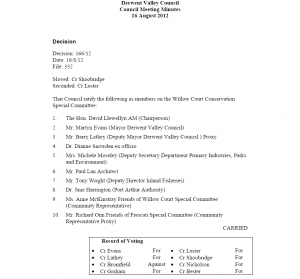 http://www.derwentvalley.tas.gov.au/webdata/resources/files/16%20August%202012.pdf
http://www.derwentvalley.tas.gov.au/webdata/resources/files/16%20August%202012.pdf
At last, the minutes of the DVC August meeting have appeared on the DVC website, we can now see the formal document and who voted which way. The minutes also have approval for stage five in the subdivision opposite Royal Derwent Hospital. Names are suggested for some of the streets, it would be nice to see a street name that recognises the history from the Residents side. What would be a good name?
I have just uploaded a new short film (21 min) of footage I had on one of the Royal Derwent visits, Most of these buildings are gone now except for the Chapel and Ward 10. Images of the past. Royal Derwent Hospital, Wards 7,8,3,4,10 and the Chapel. http://
[nggallery id=8]
A very creative web site has emerged from a young Tasmanian Student and it contains great photography and audio interviews. It is great to have more information about Willow Court and it’s history in the public domain and should raise the profile of Willow Court as a place of importance. The owner, who made contact with us on the last open day has given us permission to share links. This is a really positive story and it’s great to see younger people interested in Tasmanian Disability/ Mental Health, and Architectural History. https://willowcourttasmania.org/links/
Cheers
Mark
Rod Quarrell sizing up the work on the Willow Court gateway
Rod has worked on many heritage properties around Tasmania, including Port Arthur and has volunteered his expertise and time to restoring the beautiful old gates that face the New Norfolk township. After a chance meeting with a member from the Friends of Willow Court Committee, conversations soon came round to the restoration of the site which happened to be a passion of Rods too. Rod’s interest and expertise in heritage properties such as Willow Court have lead to our first restoration project on 7/8 Oct.
Friends of Willow Court have initiated this project and have been granted a Works Exemption by Heritage Tasmania. Four to six volunteers from FoWC will assist Rod on the first weekend in October.
Cheers
Mark
I think this article has implication for our current situation and determining our own responses in the creating of a museum of memory, whether it is a physical buildings or words in a book or a website, all these complex issues will take time, understanding and a great deal of patients.
“Those who cannot remember the past are condemned to repeat it” The exercise of memory is but one of the four essential tasks of a post Government Policy of Institutionalization if it is concerned with healing and reconciling the past practices for PWD, the other three are: truth, justice, and reparation.
This entails giving the victims and their kin the chance to recover their dignity and validate their experiences. This can only be done if their stories are allowed to be freely told, collected, and preserved. These stories must be situated in the broader context of the events that marked that period.
From all this, wrote the Jewish philosopher Avishai Margalit in his thought-provoking work, “The ethics of memory,” we may glean an ethics of remembering that must be distinguished from the politics of memory or the psychology of memory. An ethics of memory implies an obligation to remember and also to forget. It involves complex attitudes and sentiments that come with what he terms “thick” relations—relations that are “moored in shared memory.”
“Thick relations are grounded in attributes such as parent, friend, lover, care provider, fellow-countryman.” The operative themes that mark such relationships are those of loyalty and betrayal, gratitude and love. “Thin relations, on the other hand, are backed by the attribute of being human.” These are our relationships to the “stranger and remote.” Here, the operative themes are usually those of respect and humiliation. Margalit says that ethics refers to how we should live with those who are bound to us by shared memory. Morality refers to the rules that govern our relationships to the rest of humanity.
Read in this context, it becomes clear that the project of a museum of memory has to confront the tricky issues posed by the ethics of remembering. This cannot be done by a committee working separately from the communities of memory that alone must decide what to remember and what to forget. The purpose must be neither merely to exhibit the trauma of the past nor to demonize the perpetrators. If it is to succeed, a memory museum cannot have any other purpose than to reawaken the values of loyalty, forgiveness, gratitude, and solidarity that hold us together as a people bound by thick relations.
Adapted from the work of
By Randy David, Philippine Daily Inquirer
12:24 am | Thursday, September 20th, 2012